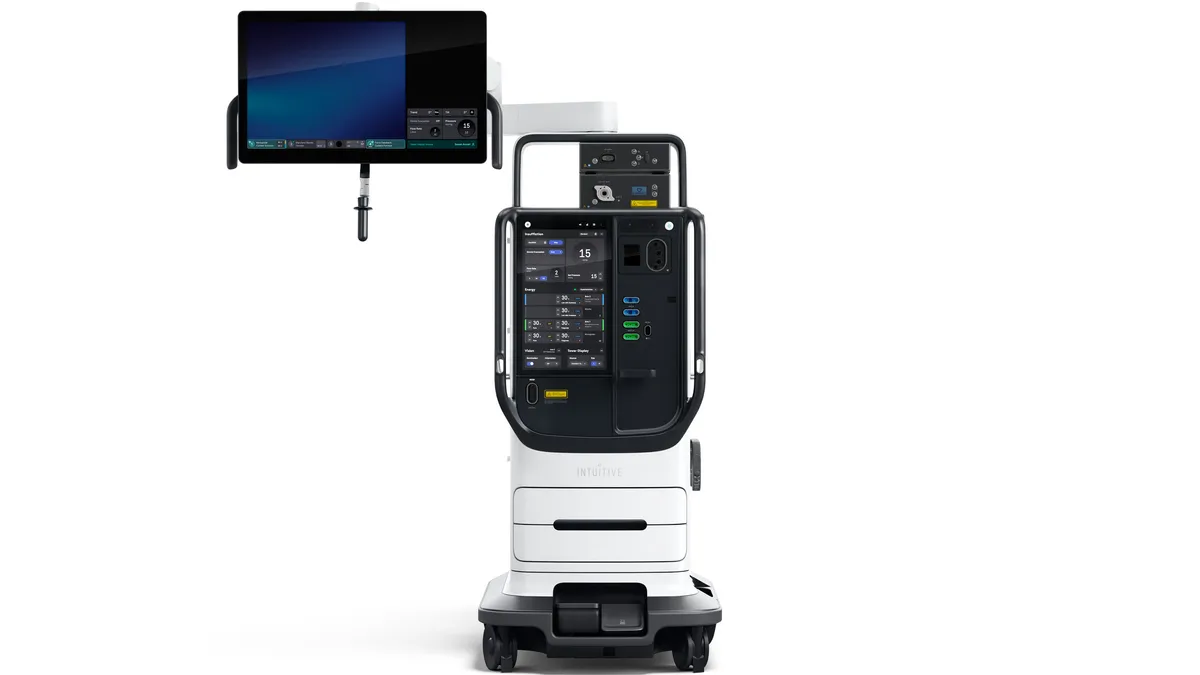Dive Brief:
- The reaction of general surgeons to Intuitive Surgical’s da Vinci 5 has reinforced Truist Securities analysts' belief the new surgical robot will widen the company’s “already substantial technology lead.”
- In a note to investors Monday, the analysts shared feedback from the Society of American Gastrointestinal and Endoscopic Surgeons meeting in Cleveland, where Intuitive allowed attendees to test drive the device last week. Meanwhile, BTIG analysts left the event believing the robot’s new technology that simulates the feeling of force on tissue, called force feedback, can help the shift to robotics.
- Truist analysts wrote that their talks with physicians at the conference suggest Medtronic and Johnson & Johnson could “be relegated to niche players” in robotics when their systems come to market.
Dive Insight:
Both sets of analysts reported positive responses to the force feedback capabilities of da Vinci 5. BTIG analysts said the feature is “a fantastic development” that may aid adoption of robotic surgery by making it easier to understand movement inside the body, as opposed to visual cues.
Truist analysts concurred, noting a “broad consensus from docs that this will be a key feature in residency training” and predicting an impact on penetration.
Estimates of the time the new features could save per procedure range from 10 minutes to 30 minutes, according to the Truist and BTIG notes. Truist analysts said “there does appear to be a fairly uniform expectation that [da Vinci 5] will reduce surgery time and set-up time” as a result of multiple features that each make a task a little faster.
Truist analysts expect the device to extend Intuitive’s lead in a market targeted by J&J and Medtronic. Two surgeons told the analysts they don’t believe the rival systems will match Intuitive’s capabilities, leading them to predict J&J and Medtronic “will compete on price and share in the stapling market.”
As well as holding off competition, Intuitive needs to persuade existing users of its systems to upgrade and get sites that still perform procedures manually to install robots. Intuitive has cleared one barrier to upgrading by creating a system that requires “little change in training, workflow or instrumentation,” BTIG analysts said, but hospitals also face financial considerations.
“We don't think [Intuitive] will have a tough time selling the first 50-100 systems to devoted users but at a $2M+ price point, economics will likely be a bigger part of the discussion for many hospitals, especially in a period where many newer systems are coming to market at lower prices,” BTIG analysts said.
The analysts estimate the systems will cost $2 million to $2.5 million, up from $1.8 million for the older Xi devices. Truist analysts said the higher price tag “does not appear to be an issue,” and got the sense that some hospitals may be more interested in leasing than buying devices. The pace at which hospitals lease systems will depend on how the agreements are structured, the analysts said.
System placements will also depend on Intuitive’s ability to supply them to hospitals. Executives cautioned on last week’s earnings call that placements would be choppy in the coming months.
Both sets of analysts discussed the potential for da Vinci 5 to pose a threat to Stryker’s endoscopic tower equipment because it integrates visualization and other features into a single tower. Stryker sells video towers and used SAGES to showcase its 1788 platform.
BTIG analysts said da Vinci 5 may harm Stryker “as hospitals who would have otherwise upgraded their video tower fleet may not need as many.” However, Intuitive told Truist analysts it is not planning to sell the tower on a standalone basis. The analysts see little near-term threat.
“Given the constrained robotic capacity that exists today in the marketplace broadly, it seems very unlikely to us that a hospital would be willing to idle a robot for a relatively small cost savings so that equipment on a tower like this could get split for laparoscopic cases,” the Truist analysts wrote.










